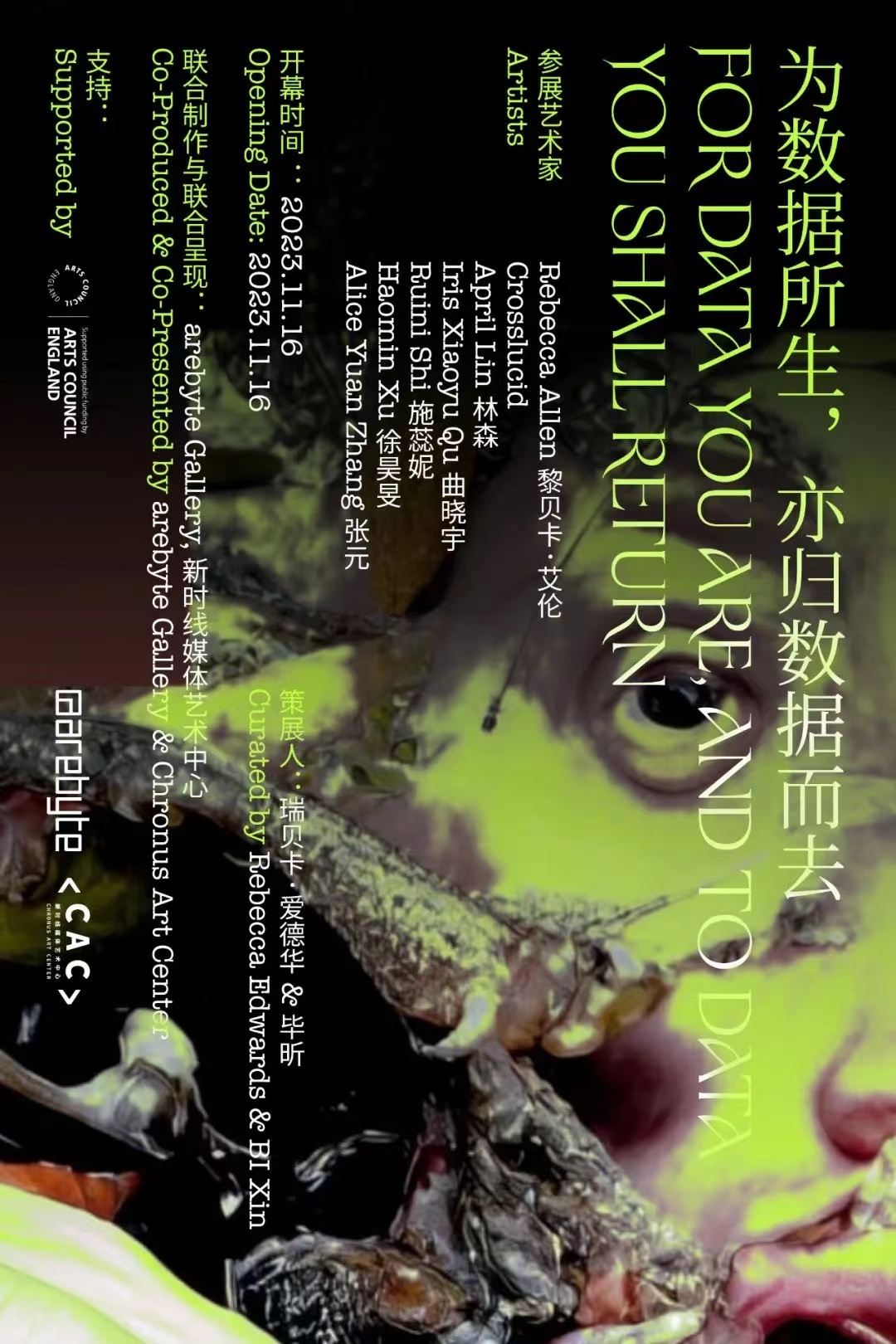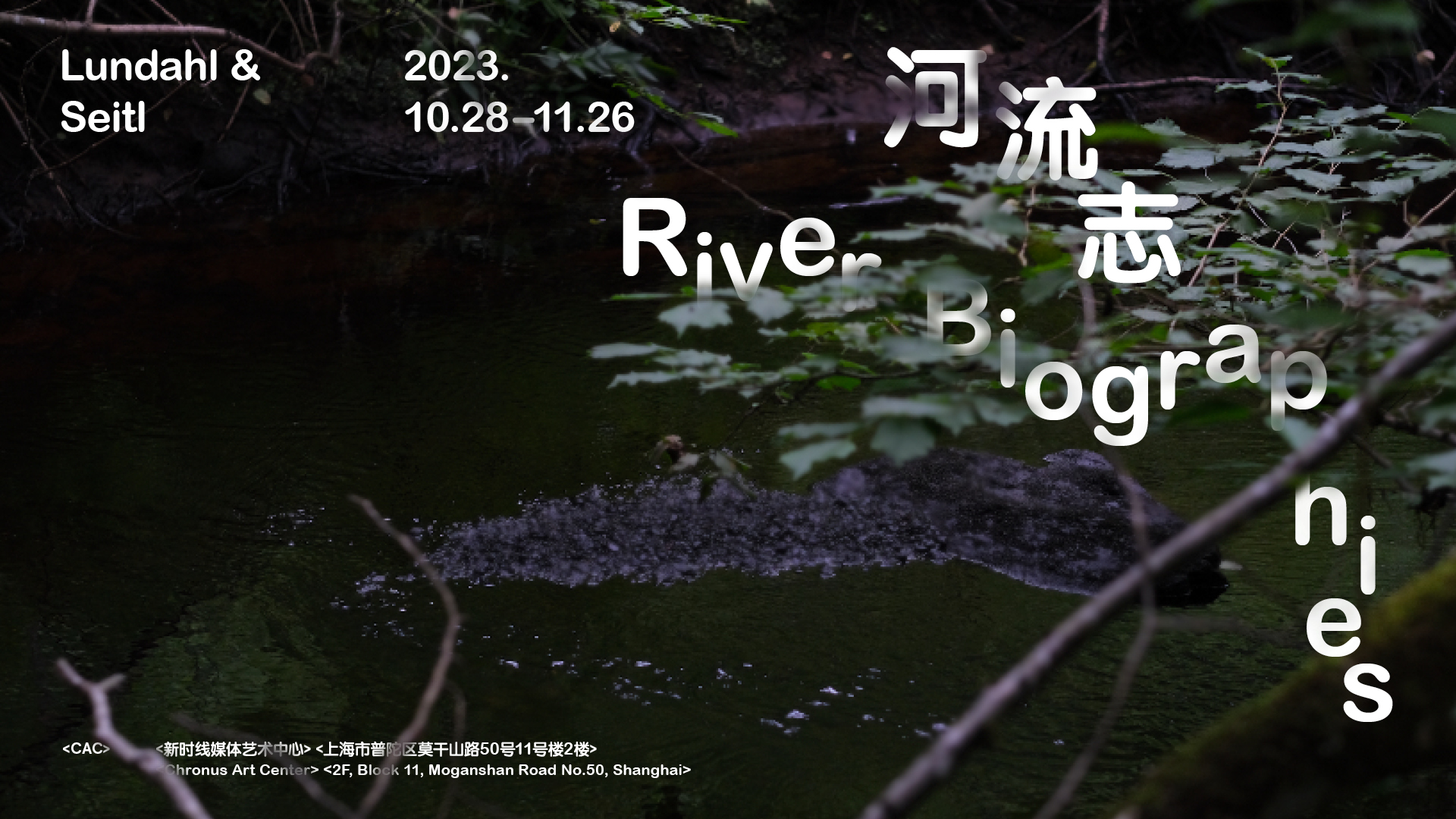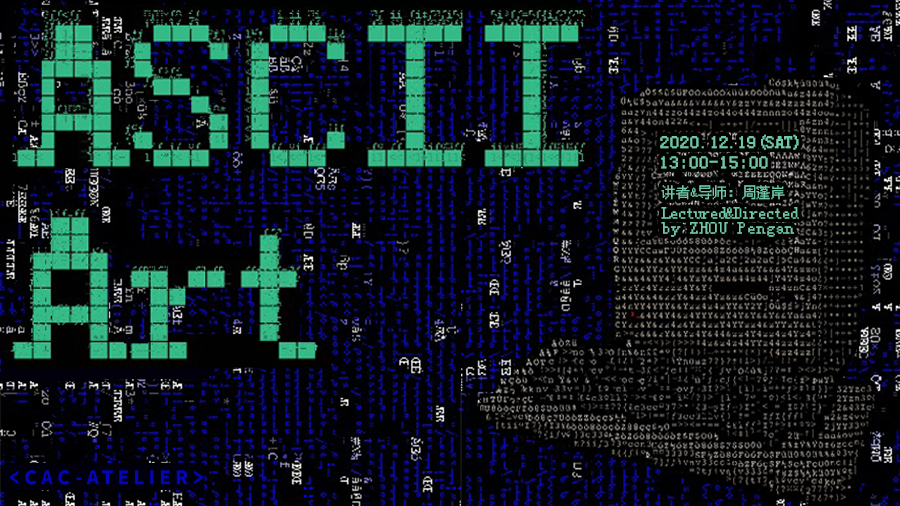 Co-presentation with We=Link, an online exhibition platform initiated by CAC, and Arebyte on Screen (AOS), a platform dedicated to artist videos, digital experiences and curatorial interventions and programming utilising web-based formats.
Co-presentation with We=Link, an online exhibition platform initiated by CAC, and Arebyte on Screen (AOS), a platform dedicated to artist videos, digital experiences and curatorial interventions and programming utilising web-based formats.
ARTISTS:
Rebecca Allen, crosslucid, April Lin林森, Iris Xiaoyu Qu, Ruini Shi, Haomin Xu, Alice Yuan Zhang
Curators:
Rebecca Edwards
BI Xin
Co-produced & Co-presented by:
arebyte Gallery
Chronus Art Center
Launch Event:
2023.11.16 (Thursday) ,1 pm UK / 9 pm China
With the support of Arts Council England

Chronus Art Center (CAC) is pleased to announce the presentation of For Data You Are, And To Data You Shall Return, the fourth iteration of We=Link, in collaboration with arebyte Gallery. Featuring artists and artist collectives Rebecca Allen, crosslucid, April Lin林森, Iris Xiaoyu Qu, Ruini Shi, Haomin Xu, Alice Yuan Zhang, the exhibition will be officially launched on November 16th, 2023.
For Data You Are, And To Data You Shall Return is an online exhibition of generative, video and gamified works exploring diverse perspectives surrounding digital death, renewal and reincarnation in the virtual domain. Surveying the nuance of long-standing and newer ruminations around the circularity of life and death, in technological, bodily, and spiritual contexts, the exhibition sees death as a narrative with which to discuss life. Death in the digital world is, in a particular dimension, describable, observable, and even manufacturable, as well as manageable and repairable. Life in the digital world is, on the contrary, more mysterious. While we acknowledge its nature of growth and the possible need for disruption, articulating precise determinations regarding its substance and characteristics remains elusive.
The online exhibition forms part of arebyte’s The Body, The Mind, The Soul programme and comprises works that span a range of digital media processes and outcomes; from hypnotic encounters with concealed code to custom playful gamifications, and planetary-scale simulations, the exhibition presents expanded video practices, role-playing narratives and reconnection with devices and their material origins, drawing links between communications across ethers and the encounters of rogue or unknown agents acting on behalf of their meatspace counterparts. Decay, sites of renewal, and rethinking our existence in the digital and environmental domain are foregrounded.
Reflecting on the idea of there being a transitional presence imbued within digitised works, the boundary between online and offline is negated: instead, the exhibition speaks to the circularity of these two ways of being through mediation of the screen and argues that one does not supersede the other.
The exhibition title is a subtle twist on the theological reference in the book of Genesis which infers non-immortality. This concept aligns with the Chinese Buddhist philosophy of “sheng-si-lun-hui,” which is tied to the idea of karma and its role as social currency in the afterlife. By imbuing the interface with a uniquely generative background - a mystical quality of exposing the underside of codified processes - and by referring to data as the dust you shall return to, the exhibition seeks to symbolise this continuous cycle of existence of all things. Although relics, ideas and bodies find renewed energy and purpose within these digital domains[1], the underlying systemic infrastructure (unless decentralised and autonomous) means that they are often fraught with barriers, boundaries and censorship, as well as capitalist ideologies.
Throughout centuries and across various cultures, the cyclical nature of life can be linked to the process of data collection and transference. When entering the exhibition, users inherently contribute their data as they would on any site (including IP addresses, interaction patterns, and browser preferences), which is then subsequently utilised within the exhibition to evoke spectral traces of previous visitors as vibrant data visualisation. When the user leaves the site, they leave this data behind, which on other websites is often referred to as a passive digital footprint, where websites collect information about how many times users visit, their location, and their IP address. Additionally, other markers and traces are also left in the exhibition which become layered over time and are expressed through heatmaps, background code that becomes visible over time, and unique experiences of some works that rely on particular user data to function.In this manner, the website transforms into a commemorative space for past guests; each user can download their personalised data pathway at the end of their session as a reminder of their data usage. Taking into account the way data is mined, manipulated and spread without consent, the exhibition encourages contemplation of how the digital space can become a sanctuary for renewal, healing, and the rediscovery of lost or suppressed narratives via this same data.
As long as we log in, load data, perform computations, and enter inputs, we are confronted with the effects of our complex, multifaceted, multi-platformed existence; the exhibition addresses this symbiotic relationship between user, data and browser suggesting a matrix of extrinsic conditions. For Data You Are And To Data You Shall Return visualises a ghost in the machinic interface, an active agent making transparent that which is often hidden, and made present by “layers” of the site eroding through the presence of human interaction and data left behind. A reminder of causality.
Technological objects interplay with time; technologies discipline and alter the trajectory, perceptual space and the scale of temporality, yet are inevitably corrupted by it. In a long epitaph in The Dead Media Project, Bruce Sterling offers condolences to "the failures, collapses, and hideous mistakes of media"[1]. The birth of some technological applications is imbued with an inevitable being-towards-death - you always need to replace an old machine with a new one, as long as you are still using it. Is this death and rebirth circle of technological objects, in fact, a misunderstanding of the true nature, temporality and behaviour of technology led by commercial pressures and marketing intervention?
Jussi Parikka and Garnet Hertz's Zombie Media theory continues further from Sterling’s ideas by claiming that “media do not die but persists as electronic waste, toxic residue, and its own sort of fossil layer of disused gadgets and electronics"[1]. The media of interest in this exhibition, the digital entities, are, as mentioned by these media theorists, dislocating and attaching themselves in bundles of yellow fibre-optic cables, underneath the geological strata, within the mountains, and under the oceans, participating in the life and decay cycle of transistors, dust, gravel, water droplets, and barnacles.
Apart from the decomposition and metamorphosis of their material basis, digital entities also perform by being replaced, decrypted and obliterated through processes of time, changeable systems and planned obsolescence. Technologies extend humans' memories, however, they also become forgotten in the process of forgetting. Deleted photos, unattended games, abandoned blogs, and obsolescent software, the advanced development of digital entities made its ontological presence a flickering uncertainty. There always seems to be an iteration that makes the "death" in the digital world seem like an optimising “reborn”. Nonetheless, ancient codes have always been the underlying computer language's profound and immutable logic, becoming a hidden act of spelling, a psychic that manipulates hardware, a ghost that latches onto the material substrate.
For Data You Are, And to Data You Shall Return is a decaying exhibition: the interface is gradually stripped down to its code, which may one day cease to function[2]; alternatively, and more likely, it will fade away in people's memories and become the fault of Epimetheus[3]. However, for it is data, and so to data it shall return, the exhibition will haunt in/on the cloud, waiting for an inadvertent click and resurrection.

arebyte advances new experimentation in digital cultures.
Meeting the growing demand for immersive experiences and digital content creation, arebyte pioneers new forms of engagement with creative technologies, to critically explore the impact of technology in contemporary society.
From digital environments, online exhibitions to live performances, arebyte’s art programme spans VR, AR, motion capture, CGI, AI, blockchain technology, and draws 10,000 visitors per year to its gallery in East London, with a yearly online audience of 350,000 which is constantly growing.
arebyte is committed to further support London’s creatives by providing affordable workspaces in the capital city. In partnership with private landlords and Councils, arebyte strives to preserve a vibrant community of 330 artists, makers and designers in East and South London.




